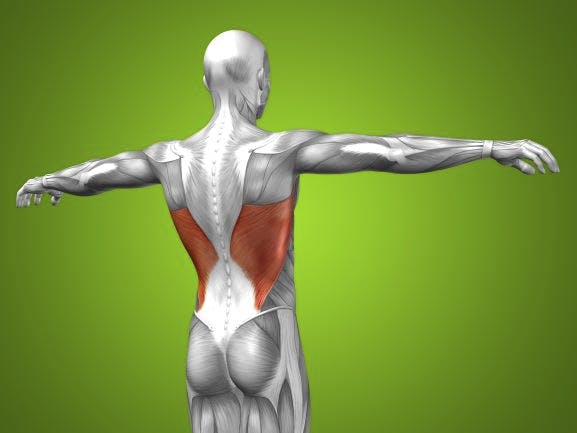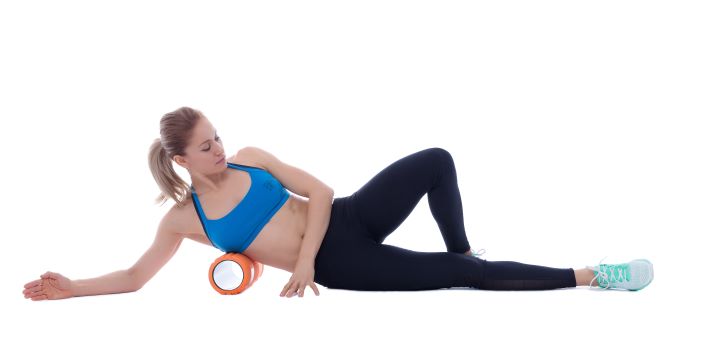The length of your lats, or latissimus dorsi muscle, affects your ability to raise your arms overhead. Shortened lats restrict overhead mobility. Short or overactive lats also pull your shoulders inward and can increase compressive forces on your low back. This commonly occurs with aging and those with rounded shoulders. Performing lat stretches reverses this problem.
The latissimus dorsi is the largest muscle of your upper body. It is a long broad muscle that originates in your low back. It spans your upper back and passes under your armpit to attach onto your upper arm. The lats function to pull your arm down and across your body. It also rotates your arm inward toward the middle of your body. Common exercises which include these movements and strengthen your lats are pull-ups, pull downs, and rows. It is also highly active during other common exercises such as presses, squats, deadlifts, and planks.

Many exercises performed in the gym require full overhead mobility. Also, many of us perform daily activities which require overhead reaching. When lats are short or overactive, the brain will take the path of least resistance and figure out a way to compensate. This often manifests by excessively arching the low back when reaching overhead. The following four exercises are examples of stretches for the lats. Performing these regularly can improve overhead shoulder mobility and spare your low back from unnecessary stress.
Foam Rolling the Lats
Brief periods of foam rolling can reduce overactivity or tension in your lats. This is a nice way to prepare your lats for the next two stretches. Performing about 30 seconds of foam rolling is usually adequate. Longer periods are rarely needed. Lie on your side with the foam roll positioned in the area of your armpit. Bend your bottom leg and straighten the top leg. The palm should be positioned facing up to rotate the upper arm. Engage the abdominals slightly to maintain a posterior tilt of your pelvis. Slowly roll up and down covering an area of about 6 to 12 inches. Gentle pressure is all that is needed. Aggressive pressure or foam rolling often increases tension in your lats.
Active Lat Stretch in Quadruped
Assume a kneeling position with both elbows resting on the floor. Reach up and across the body with the side to be stretched. Also, rotate your palm upwards. Slightly sit back on your heels to increase the stretch felt in your upper back or armpit. Engage your abdominals slightly to maintain a tilt of your pelvis. Hold this position for 10 to 30 seconds. Deep breathing can be incorporated to relax and further stretch the muscle. Gentle stretching is all that is needed.
Supine Flexion
By lying on your back and flexing your arms overhead, shoulder flexion is assisted by gravity. To increase the stretch to your lats, position your palms up. As you gain mobility, move the hands closer together. You can also perform the exercise lying on a bench to allow for greater range of motion overhead. Be sure to keep your abs engaged and low back flat to avoid compensations.
Bench T-Spine Mobilization
This is my favorite exercise for restoring thoracic spine extension and stretching the lats. The exercise begins by assuming a kneeling position facing a bench. Place your elbows on the bench in front of you holding a PVC pipe or dowel with the palms facing up. Sit back, pushing your buttocks towards your heels. Engage your abdominal muscles to maintain a slight tilt of your pelvis. You should feel a nice stretch in your upper back or arm pit. For an added stretch you can bend your elbows further past your head. Hold this position for a few seconds, and exhale fully. Reverse the motion to return to the start and repeat for 10 to 20 repetitions.
Final Thoughts on Stretching Your Lats
Improving the length of your lats takes patience and persistence. This is a big strong muscle that is prone to overactivity and tightness. Stretching 3 to 4 times per week for several weeks is needed to see any meaningful improvements. Increase your chance of success by also performing abdominal and thoracic spine mobility exercises. With consistency, you will see a payoff in your ability to perform overhead movements. If you are unsure about how to get started, meet with your physical therapist.


